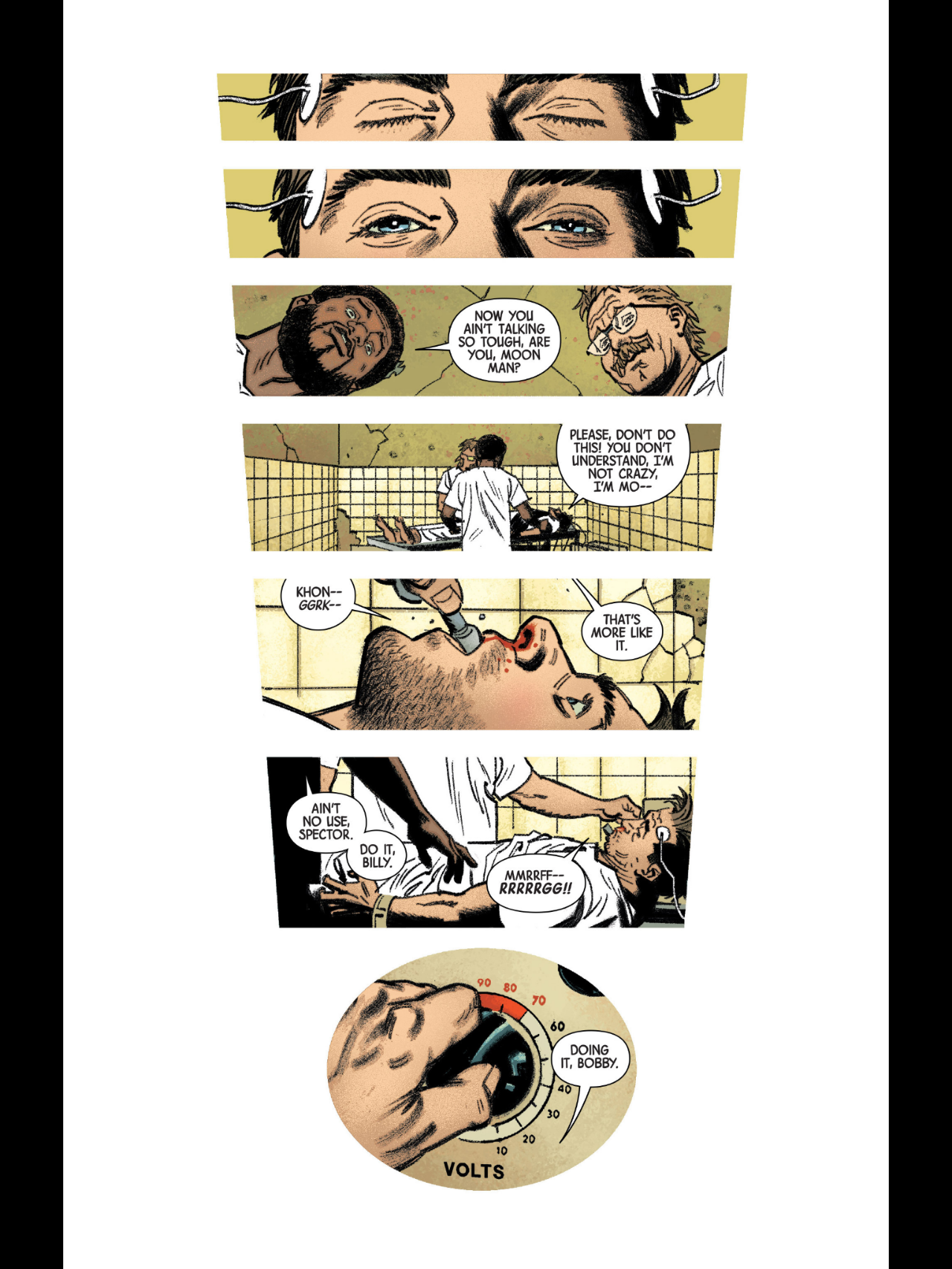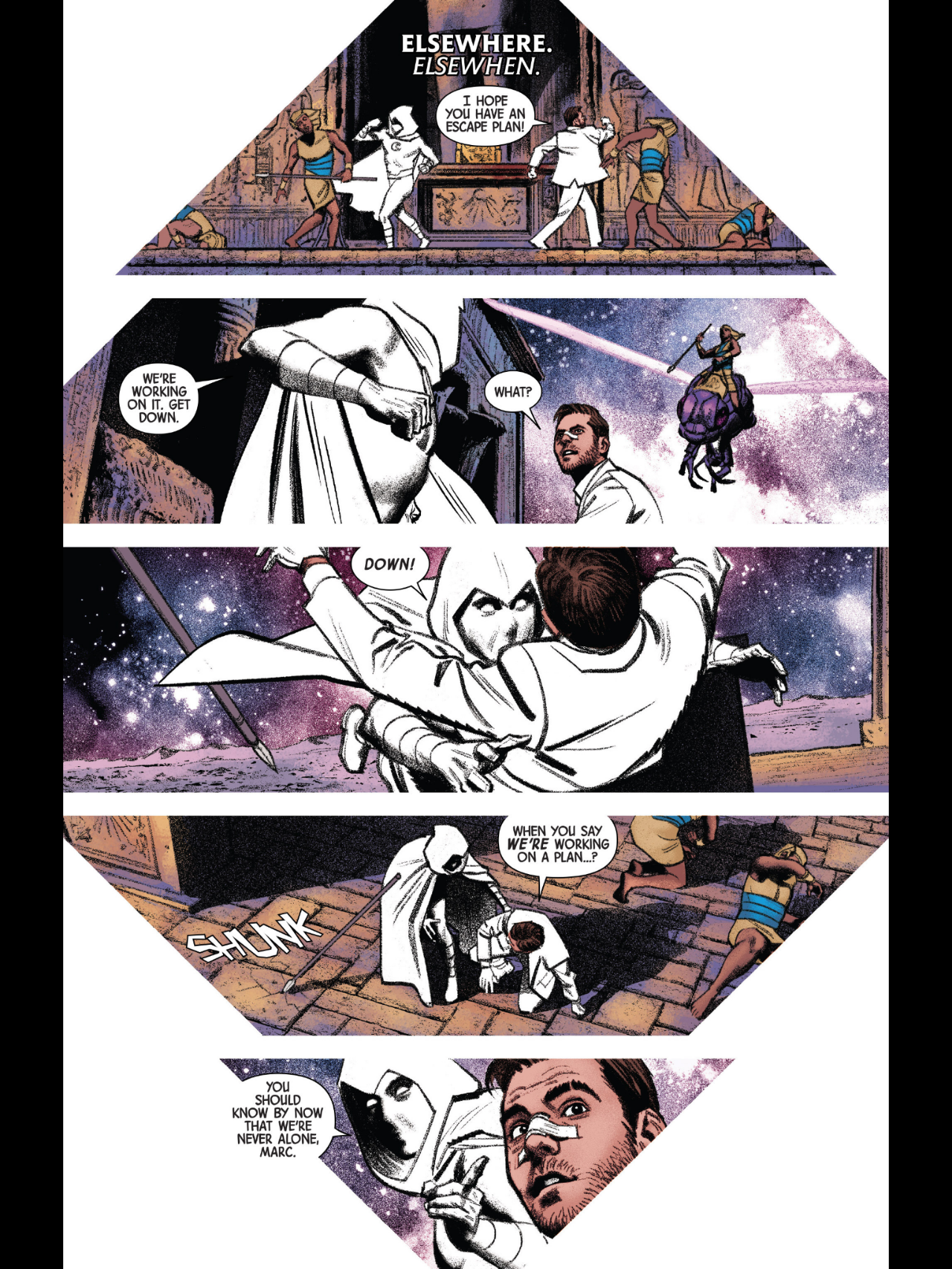During the Ellis/Shalvey/Bellaire run on Moon Knight there’s a sequence where the titular hero battles through a mushroom-induced dreamscape, fantastically rendered in rainbow-like colours before he crashes through what looks like a brain and faces the force behind it all.
The more recent run by Jeff Lemire, Greg Smallwood and Jordie Bellaire takes this idea of Moon Knight fighting on a metaphorical landscape and extrapolates it into an internal struggle within the mind of Marc Spector himself. By doing so, as well as using recurring visual motifs, they produce a shattered, fragmented version of Joseph Campbell’s ‘Hero’s Journey’.
Mix this in with overt references to Marc’s disorder and an undercurrent of good old Jungian Ego-Death and you have a story that is no less dramatically loaded than one taking place in the physical plane.
///

We start, of course, with the moon. Straight away we notice Smallwood’s line work is looser, coarser even, with Bellaire’s diffuse colours giving the opening page the feel of a dream. Marc hears a voice, rendered in a hieroglyph style font by Corey Petit. The letters are balloon-less. Khonshu is everywhere.
Directly beneath the moon is our first full look at Marc, glancing upwards in reverence. Further down is a shot of Marc dwarfed by a temple and statue of Khonshu. Again, Marc is at the feet of the deity. We’re on Page One and we already have two examples of Marc beneath, or in supplication to, the moon and/or Khonshu. This will recur again and again as the story continues.
The moon, Marc, the temple and Khonshu are all aligned down the central axis of the page. Everything is in balance, in order, as it should be. Khonshu’s voice beckons Marc onwards, marking what Campbell refers to as ‘The Departure’ with the protagonist receiving the call to adventure (usually from a mentor-like figure).
In Christopher Vogler’s ‘The Writer’s Journey’ (a kind of marriage between a ‘how to’ book and a primer on Campbellian structure) he names ‘The Shapeshifter’ as one of seven archetypes that occur in fiction. The rub is that ‘The Shapeshifter’ can change roles throughout the narrative, becoming a different archetype as the protagonist moves through the narrative. Khonshu has the hallmarks of the mentor figure here, but it won’t always be that way. As Marc uncovers the truth the sands will shift.
On the second page Marc enters what looks like a graffiti-laden subway. He's descended into the temple into the bowels of a city to be met with a doorway of glowing yellow light. The idea and physical act of descent is a recurring visual motif, directly linking to Campbell’s idea of the descent into the underworld. Again, Marc is aligned with the door, his goal, and Khonshu’s voice, down the centre of the page. One other thing worth keeping in mind is that Marc is injured, clutching a stomach wound and complaining that he “feels like his guts are slipping out”. Marc continues towards the light.
Next, Marc comes face to face with Khonshu, standing before the seated deity before conceding his stance and lowering himself to be at the God’s feet. It’s here we learn Marc and Khonshu have the same goal, rebirth, but their methods and proposed end games are entirely different. As Marc pulls the Moon Knight mask over his face he is subject to a flood of memories of his disparate identities as Smallwood’s diffuse style gives way to something more solid and traditional.
As Marc attunes to this new reality, Bellaire dots the pages with tiny splashes of yellow and red. Yellow often has positive aspects (warmth and happiness), but can also signify deceit, our first hint all is not as it seems.

Red though? Red is not good either. The orderlies, Marc being punched and kicked, his bloodied nose and even the syringe he receives are all accentuated by red. By rooting the page in a simpler pallette than what’s come before, Bellaire gives the reader the impression of a more tangible reality than the one we opened with. It’s a clever way to fool the reader into thinking this is reality and Marc has finally cracked.

As the syringe delivers its payload we get a series of wide panels that diminish in size as we move our eyes downward, watching as Marc descends into the white void. As he regains consciousness the structure holds with the panels decreasing in size to a circular panel with the voltage switch on the shock therapy machine serving as a visual dot on this exclamation mark style visual. The room, tiled in yellow, is offset by the tiny splashes of red on Marc’s bloodied nose and the dial on the machine.
As the current surges through Marc’s body we see a shot of him arching his back in pain, as if awaking from a slumber or nightmare. This pose and visual will also be repeated throughout the story, often marking a departure point or passage into another reality for Marc. Pain is what’s guiding him.

When Marc awakens he is sat, posed almost like Khonshu surveying his domain – a severely decrepit looking mental hospital. Smallwood gives the room an art deco look that has gone to seed, hinting at past glories now wilted, a nice visual tie to Marc’s current status. It’s here we also meet Marc’s allies – Gena, Crawley and Marlene (but no Frenchie yet). As he sees them for the first time each are accompanied by a panel harkening back to days gone by using the hazy dreamlike style of the opening pages.
Dr Emmet, in charge of Marc’s treatment, is introduced soon after (dressed in red of course). She tells Marc the Moon Knight mythos is all a lie, a narrative sat atop the one true reality, blinding Marc from seeing things as they really are. She stands at one point and Marc, with his head bowed, seems smaller than those who seek to control him.

As night falls, Marc lies still in his bed, the stark whites and blacks making him look a sarcophagus. When he attempts to break out his cell we see a shot of the orderlies entering and then Marc standing before them in a makeshift Moon Knight costume. In the central panel he is framed by the orderlies arms, framing him, but giving a downward triangular shape, a pyramid that also serves to lead the eyes downward to a reveal of the orderlies as mythical creatures. Marc is literally standing between two planes of reality.

As Marc launches himself at the orderlies the yellow, so prominent up until now, is overwhelmed by whole panels bathed in red. They all show Marc lashing out violently. It hints that violence, Marc’s default mode of thinking, may not be the answer.
Marc then attempts to escape the hospital by ascending a staircase leading to the roof. As he does, the panels decrease in size again, creating a sense of descent. However this time , due to mark moving upwards, the panel size creates a sense of dissonance. This path is not the right one.

As Marc looks out over the rooftops he’s met with the sight of a New York buried beneath sand, as a gigantic pyramid dominates the skyline. As Marc grapples with what he’s seeing the page is laid out into fifteen panels, dividing Marc and giving us a metaphor for his fracturing psyche. The page also places Marc directly beneath the moon once more as Khonshu’s voice rings out.
The location may have changed, but we are right back where we started. This is Marc crossing the 'First Threshold' as Campbell coined it, but failing to progress any further. There is still too much internal conflict.
It becomes apparent that to win this battle, maybe his most important battle, Marc is going to have to adhere to another Jungian idea – the death of the ego.
#comics #analysis





























